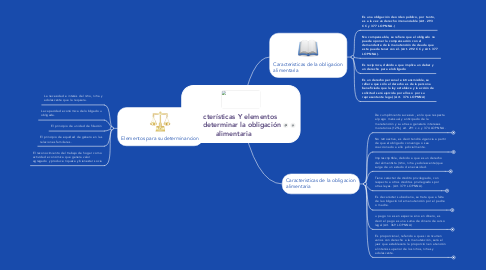
1. Elementos para su determinancion
1.1. La necesidad e interés del niño, niña y adolescente que la requiera.
1.2. La capacidad económica del obligado u obligada.
1.3. El principio de unidad de filiación
1.4. El principio de equidad de género en las relaciones familiares.
1.5. El reconocimiento del trabajo de hogar como actividad económica que genera valor agregado y produce riqueza y bienestar socia
2. Caracteristicas de la obligacion alimentaria
2.1. Es una obligación de orden público, por tanto, es a la vez un derecho irrenunciable (Art. 293 CC y 377 LOPNNA.)
2.2. No compensable, se refiere que el obligado no puede oponer la compensación con el demandante de la manutención de deuda que este pueda tener con él. (Art. 292 CC y Art. 377 LOPNNA).
2.3. Es recíproca, debido a que implica un deber y un derecho para el obligado
2.4. Es un derecho personal e intransmisible, se refiere que sólo el derecho es de la persona beneficiada que la ley establece y la acción de solicitud será ejercida por ellos o por su representante legal, (Art. 376 LOPNNA)
3. Caracteristicas de la obligacion alimentaria
3.1. De cumplimiento sucesivo, en lo que respecta al pago mensual y anticipado de la manutención y su atraso generará intereses moratorios (12%), art. 291 c.c. y 374 LOPNNA.
3.1.1. Situational Analysis / Drivers
3.1.1.1. What is driving us to do this?
3.1.1.2. SWOT Analysis
3.1.1.2.1. Strengths
3.1.1.2.2. Weaknesses
3.1.1.2.3. Opportunities
3.1.1.2.4. Threats
3.1.1.3. Customer Findings - What have we learned from customers?
3.1.2. Competitive Analysis
3.1.2.1. Do we have competitors and threats in these target markets with the proposed offerings?
3.1.2.2. What are our competitors doing and how are they positioning?
3.1.2.3. How do we position against each competitor?
3.1.3. Target Customer(s)
3.1.3.1. Buyer Profile
3.1.3.1.1. Title
3.1.3.1.2. Industry
3.1.3.1.3. Geography
3.1.3.1.4. Business Size
3.1.3.2. Influencer Profile
3.1.3.3. User Profile
3.1.3.4. What do customers want and need?
3.1.3.5. What business problems do each of these customers have?
3.1.4. Customer Segmentation
3.1.4.1. Which customers or sets of customers do we sell to?
3.1.4.2. What are the target market segments that we want to go after?
3.1.4.3. What are the distinct problems for each segment of the market?
3.1.5. Total Available Market
3.1.5.1. New Prospects
3.1.5.1.1. How much of each target segment have we penetrated?
3.1.5.1.2. How much opportunity is available in each target segment?
3.1.5.2. Existing Customers
3.1.5.2.1. Can we up-sell existing customers?
3.2. No retroactiva, es decir tendrá vigencia a partir de que el obligado convenga o sea coaccionado a ello judicialmente.
3.2.1. Service Offer
3.2.1.1. What are we selling?
3.2.1.2. Product Definition
3.2.1.3. Pricing
3.2.1.4. Packaging
3.2.1.5. Positioning
3.2.2. Value Proposition
3.2.2.1. What is the Value Proposition to the Customer?
3.2.2.2. What pain are we solving?
3.3. Imprescriptible, debido a que es un derecho del alimentista (niño, niña y adolescente) que surge de un estado de necesidad.
3.3.1. Revenue Forecasts
3.3.1.1. Revenue and P&L Forecast (5 Years)
3.3.1.2. Revenue should be split out quarterly
3.3.2. Cost Analysis
3.3.2.1. Should include a description of the costs in entering this business and profitability analysis
3.3.3. Profitability Analysis
3.3.3.1. P&L for the offer to include gross margin, net income and break even analysis.
3.4. Tiene carácter de crédito privilegiado, con respecto a otros créditos privilegiados por otras leyes. (Art. 379 LOPNNA).
3.4.1. Sales Strategy
3.4.1.1. Direct Sales Strategy
3.4.1.2. Inside Sales Strategy
3.4.1.3. Channel Sales Strategy
3.4.2. Partner Strategy
3.4.2.1. Channel Strategy
3.4.2.1.1. What 3rd party channels should we consider for reselling this service?
3.4.2.2. Technology Partnerships
3.4.2.2.1. What technology vendors (if any) do we need to work with to execute on this plan?
3.4.2.3. Solutions Partners
3.5. Es de carácter subsidiaria, se trata que a falta de la obligación de manutención por el padre o madre.
3.5.1. Positioning & Messaging
3.5.1.1. What is the key messaging and positioning for the service offer? (Pain, alternatives, solution)
3.5.1.2. How do we communicate internally?
3.5.1.3. How do we communicate externally?
3.5.2. Promotion Strategy
3.5.2.1. Marketing Programs (Installed base versus new prospects)
3.5.2.2. Advertising (Publications, etc.)
3.5.2.3. Analyst Relations (Target Analysts)
3.5.2.4. Public Relations
3.5.2.5. Events (Trade shows, SEO/SEA, Seminars)
3.5.2.6. Webinars
3.5.3. Demand Generation & Lead Qualification
3.5.3.1. How do we generate and qualify new leads for the target offer?
3.5.3.2. Prospect Lists
3.5.3.3. Key Questions to Ask
3.5.3.4. Sales Collateral
3.5.3.5. Presentations
3.5.3.6. Data Sheets
3.5.3.7. White Papers
3.5.3.8. ROI Tools
3.5.3.9. Other Sales Tools (web site, etc.)
3.6. u pago no es en especie sino en dinero, es decir el pago es una suma de dinero de curso legal (Art. 369 LOPNNA)
3.6.1. Numbers, budget, waterfall, break-even (cost>leads>trials>deals)
3.6.2. Sales Programs
3.6.3. Accelerated Learning Strategy, Controls, Metrics
3.6.4. Include feedback loops
3.6.5. Include financial metrics (definition of success)
3.6.6. Pipeline reports, etc…
3.7. Es proporcional, referido a que si concurren varios con derecho a la manutención, será el juez que establecerá la proporción en atención al interés superior de los niños, niñas y adolescente.
3.7.1. M&A?
3.7.2. Risk Analysis & Mitigation
